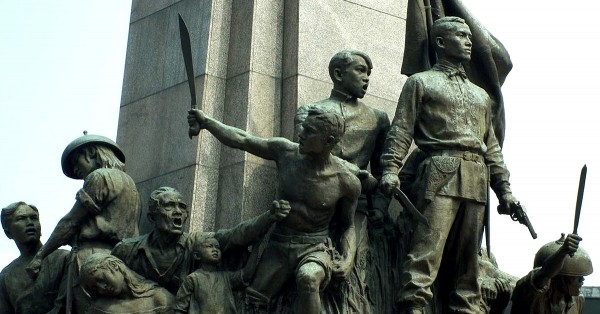The Bolo is the Filipino machete. Its blade is slightly shorter than that of the Latin American sister, but equally dangerous. The martial arts of Arnis, Kali and Eskrima teach classic slashing techniques for this weapon.
The Bolo has a steel blade which is sharpened on one side. The blade is curved, shifting the center of gravity to the top end. There are many shapes and forms. Particularly bulbous Bolos are suitable for hacking and therefore used in field work or trail blazing. Other models have been developed for the fight. They have a flatter blade that allows for quick cuts. The handle is made of hardwood or buffalo horn most of the time. Often it is bent towards the edge, similar to a pistol grip. The Spanish colonial power sporadically forced the Filipinos to break off the tips of their Bolos. Still today, many blade shapes seem truncated.
The Bolo in the Fight for Independence
In the Philippines, the Bolo is also seen as a symbol of the fight for independence. At the end of the 19th century, the secret society Katipunan organized the resistance against the Spanish colonial rule. The group cultivated conspiratorial rituals inspired by the Masons. The leaders wore Bolos on their belts. In August 1896, the Katipuneros stepped out of the shadows and proclaimed the independence of the country. In the Caloocan region, they publicly tore up their identity papers. An advancing army unit was defeated in fierce street fighting.
The event, usually called the "Cry of Pugad Lawin", marked the beginning of the Philippine Revolution, which resulted in a short-lived republic. Today, Caloocan is located in the densely populated metropolitan area Metro Manila. In the middle of the noisy city, at the intersection of the pulsating arterial road EDSA, you can find the Bonifacio Monument. The monument commemorates the first uprising of the independence movement and its leader Andrés Bonifacio. It shows 20 revolutionaries as heroic bronze statues. In their hands they wield revolvers and bolos.
The Bolo Today: Living Tradition
As a tool, the Bolo is still very present in everyday life in the Philippines today. Street vendors sell rough models almost everywhere, especially in rural areas. For example, coconuts are opened with them, but they are also used for harvesting rice or soybeans. Classic styles of Filipino Martial Arts teach how to handle Bolos in combat. They’re part of a living tradition like other blade weapons such as the Barong machete, the Kampilan sword or the Balisong knife (known in the West as "Butterfly Knife").
Did you like this article? Follow Fightingsticks on Facebook and Pinterest.
Photo: Mello47 / Wikimedia (CC BY-SA 3.0)

